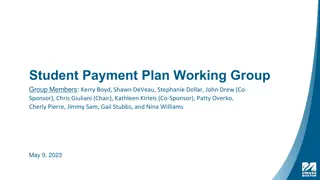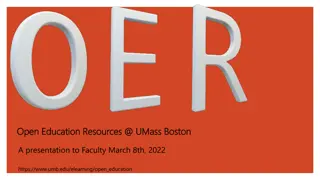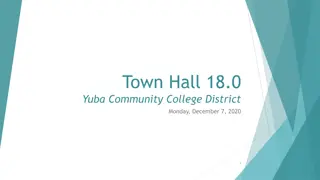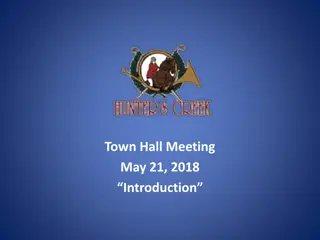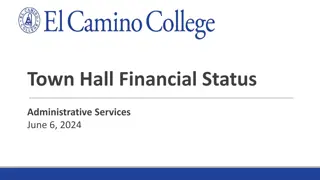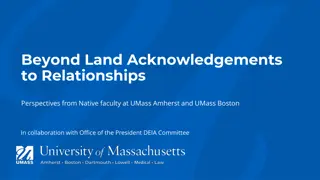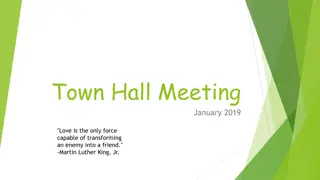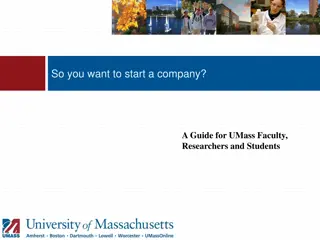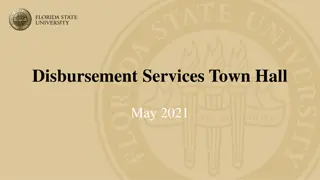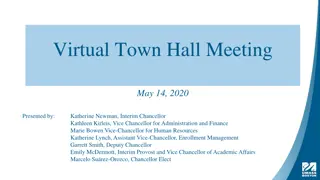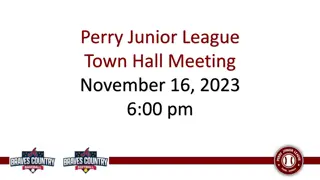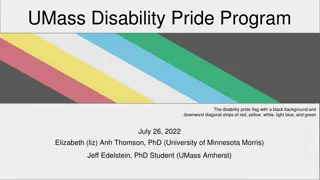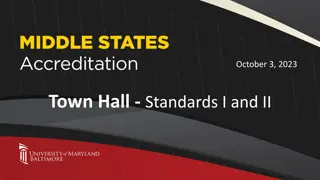UMass Boston Town Hall Meeting Update
UMass Boston presented FY17 results, FY18 budget, capital projects, and more at a town hall meeting. Highlights included operating revenue and expense data, operating margin trends, expense reductions, and achievements starting FY18. The university celebrated milestones such as record freshmen enrollment and construction progress.
Download Presentation

Please find below an Image/Link to download the presentation.
The content on the website is provided AS IS for your information and personal use only. It may not be sold, licensed, or shared on other websites without obtaining consent from the author. Download presentation by click this link. If you encounter any issues during the download, it is possible that the publisher has removed the file from their server.
E N D
Presentation Transcript
Town Hall Meeting October 12, 2017 Presented by: Barry Mills, Interim Chancellor Kathleen Kirleis, Vice Chancellor for Administration and Finance Emily McDermott, Interim Provost and Vice-Chancellor of Academic Affairs
Agenda Introduction FY17 Results FY18 Operating Budget Capital Projects Update Parking Update Academic Program Questions and Comments
FY17 Actual Results FY17 Forecast (in $ thousands) FY17 Actual (in $ thousands) Operating revenues 424,311 421,461 Salaries and fringe benefits Non-personnel operating expenses Scholarships and fellowships Depreciation expense Interest expense Total operating expenses 281,414 99,589 14,102 23,321 12,885 431,311 275,330 98,250 16,160 22,247 12,476 424,463 (7,000) (3,002) Deficit
Operating Margin Trend FY17 Town Hall 16,847 424,310 431,310 -7,000 -1.6% FY17 Actual FY14 FY15 FY16 Enrollment (headcount) Revenue $ (in thousands) Expenses $ (in thousands) Operating margin $ (in thousands) Operating margin % 16,277 354,137 347,427 6,710 1.9% 16,756 376,122 377,435 -1,313 -0.8% 17,030 406,403 411,912 -5,509 -1.4% 16,847 421,461 424,463 -3,002 -0.7%
FY17 Operating Expense Reductions Base budget reductions Lower staffing costs/hiring freeze $3.5M Capitalization of equipment $2.3M Financial aid (lower enrollment) $1.0M Deferred IT investments Shuttle/utility savings Graduate students/waivers $410K Capitalization temporary parking $408K NUP voluntary furlough $11.2M $1.2M $1.2M $234K
FY18 Start Cause for Celebration A positive start to FY18 includes: This fall, UMass Boston welcomed the largest freshmen class, with 1,881 students, and the largest new undergraduate class, 3,425 students, in its history. Our major construction projects the UCRR, student residence hall, and new parking garage are making substantial progress and are on course to be completed during this academic year. UMass Boston faculty continue to be recognized for achievements in teaching and research, as well as for service to the community. UMass Boston rose in U.S. News & World Report s top-tier National Universities category and for the third year in a row, UMass Boston won Princeton Review Best in the Northeast honors.
The $30M Deficit as presented at the May 2017 Town Hall FY18 (in $ millions) Revenues 427.8 Operating budget Depreciation expense Subtotal expense (431.6) (25.3) (456.9) (29.1) Surplus/(Deficit)
Deficit Change to $18M As FY17 activity was completed, model assumptions were updated based on work completed to date. FY18 (in $ millions) Deficit Plus: Increased state appropriation for fringe benefits Additional tuition and fees revenue Miscellaneous increased revenue Less: Payroll and fringe benefits Non-personnel cuts that would carry over to FY18 Depreciation and interest expense update Deficit (29.1) 1.2 .4 .2 3.5 4.5 .8 (18.5)
FY18 Budget Planning Process Steps Taken The UMass system has given us a target of getting to a $5M deficit. Over the last few months, conversations with leadership, both academic and administrative, have taken place. What was looked at and talked about was trying to understand, as a guide rather than a mandate, what it would look like in different areas of the university if there was: A 10% reduction in personnel costs based off of FY17 committed A 10% reduction in non-personnel costs based off of FY16 actuals. Planning focused on maintaining the integrity of the university s academic program. Proposed plans were reviewed for alignment with available resources and campus priorities.
FY18 Budget Planning Process New Costs The FY18 budget also includes the following new costs: Residence Halls/24-7 operations $1,844K Collective bargaining parameters $540K Additional financial aid $490K Adjust utilities budgeting for ISC and University Hall $434K
Closing the Gap - FY18 Savings Plans Implemented to Date FY18 (in $ thousands) NTT savings and associated fringe benefits costs Voluntary Separation Incentive Program Voluntary Separation Incentive Program benefits Early Learning Center closure January 2018 1,123 827 880 259 3,089 Total
Remaining FY18 Budget Gap FY18 (in $ thousands) (18,551) FY18 budget gap Less: FY18 savings plans implemented to date 3,089 Total remaining gap 15,462
Closing the Gap Additional FY18 Plans FY18 (in $ thousands) Cost of Living Adjustment parameters Increased financial aid to students Non-personnel operating expense reductions vice chancellors Non-personnel operating expense reductions Academic Affairs Temporary employees (CC) reduction Printer consolidation project Additional miscellaneous savings Total (540) (490) 3,632 2,400 1,000 100 480 6,582
Remaining FY18 Budget Gap FY18 (in $ thousands) FY18 budget gap after completed implemented savings Less: FY18 savings plans to be implemented Total remaining gap (15,462) 6,582 8,880
Staffing Discussions As part of the budget planning conversations, discussion was held with the deans and vice chancellors about how the staffing in their areas might look with a 10% reduction compared to FY17 committed funds with: No reductions to tenured faculty No reductions to tenure-track faculty No reductions to NTT s
Remaining FY18 Budget Gap FY18 (in $ thousands) FY18 budget gap after completed implemented savings Less: FY18 savings plans to be implemented Total remaining gap (15,462) 6,582 (8,880) Personnel savings 1,800 (7,080) Amount of deficit remaining
Personnel Reductions Involves 40 70 positions Tentative plans are presently being reviewed Discussion with unions to take all appropriate steps Notifications to be completed in November
Next Steps to Get to $5M Deficit or Better To close the remaining budget gap, further areas of university operations are under review and being discussed Centers and institutes Negotiated furlough Program review Temporary employees Reorganization of administration and finance functions Reorganization of marketing
What Does This Mean for the Future? A pathway is there to solidify the university s financial future The university is being right-sized to support our current operations and to become better Can make decisions on how to move forward Can focus on how to grow net revenue, including Increased enrollment Online education Bayside development Be in a better position to solve the remaining funding needs for the substructure project
New Project Substructure / SDQD Substructure/SDQD project approved by board of trustees in the amount of $155.5M. The Commonwealth s FY18 capital plan appropriates $78M of funding over the next three fiscal years, beginning with $6M in FY18. Relocation work for the Science Center and athletics areas is underway.
Projects Removed from the Capital Plan Tri-generation plant - $27.5M Public safety and athletics building - $22.7M Various other projects - $11.7M New pool - $10.0M New greenhouse - $4.5M Total - $76.4M
Project Funding Update Parking Garage Originally approved by the board of trustees as a P3 project Now approved as a debt-financed project in the amount of $71M, scheduled (and on track) to be completed after the end of academic year 2017-2018 Debt service on the garage is $4.1M annually.
Campus Parking The construction of the parking garage and the fact that parking rates have not increased in several years has made it necessary for the university to look at its parking rates. The campus has hired Walker Parking Consultants to help develop an overall transportation strategy, including recommendations on parking fees to support the university s parking and shuttle services. Recommendations expected to be out later this month and then there will be conversations with the unions and appropriate parties as we are required to do.


